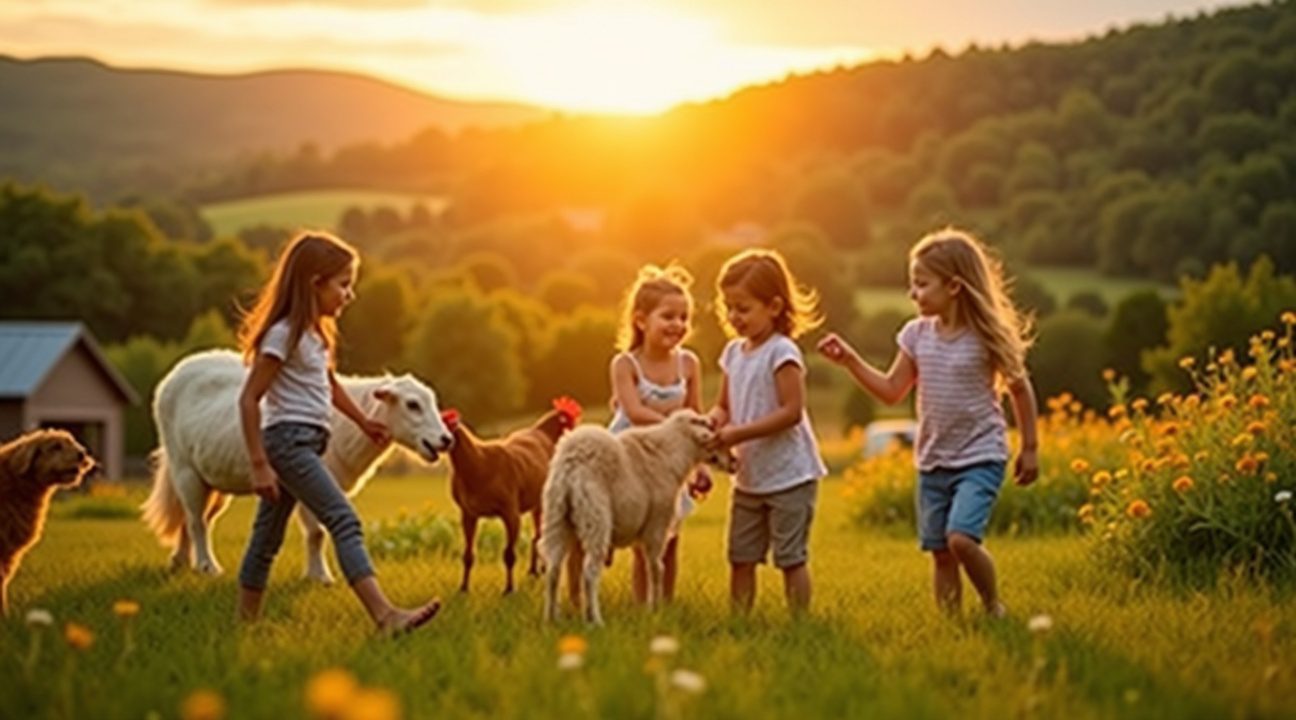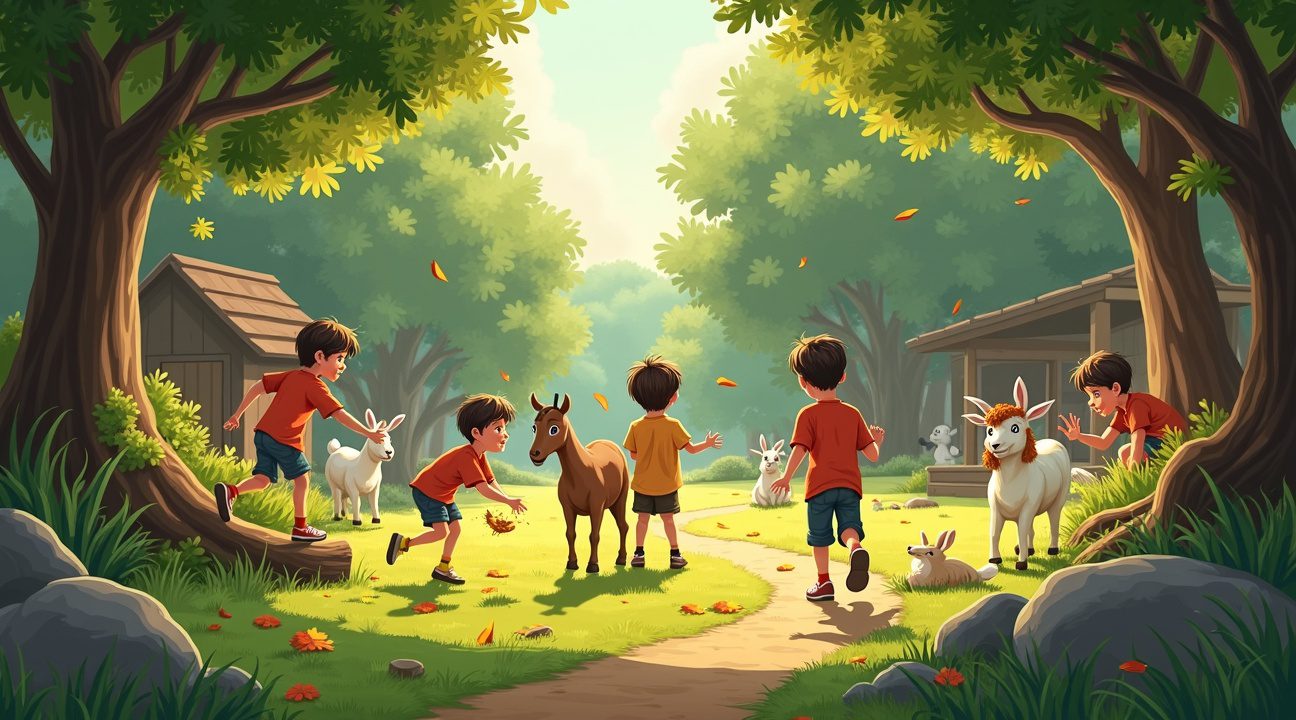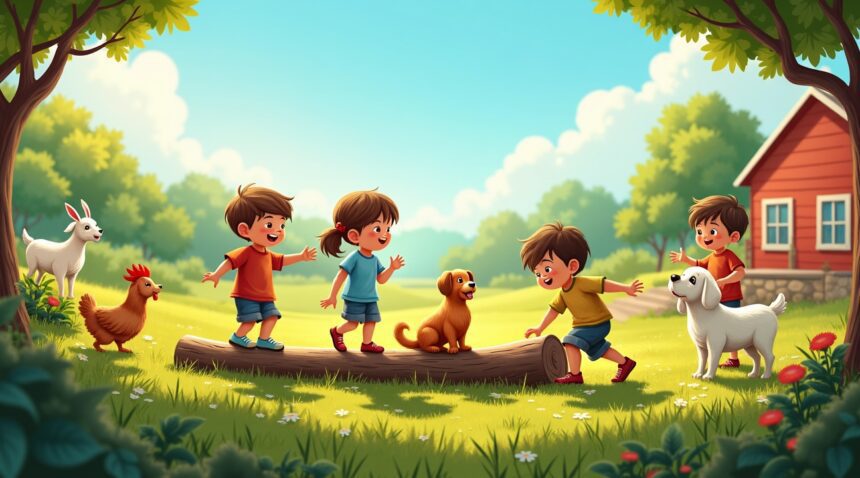Research published in PNAS and Allergy demonstrates that children raised in rural environments with regular animal exposure face up to 55% lower risk of developing psychiatric disorders compared to urban children without pets or natural biodiversity.
This protection extends to a range of mental health conditions such as anxiety, depression, and schizophrenia. Additionally, it bolsters immune systems through exposure to beneficial microbes found in nature.
Key Takeaways
- Children with regular animal and nature exposure show 55% lower rates of mental health disorders such as anxiety, depression, and schizophrenia, especially when compared to urban children without access to pets or biodiversity.
- Early childhood is the most critical period for developing protective mental health benefits, particularly for children who begin animal interactions before the age of five, gaining stronger immunity against psychiatric conditions later in life.
- Diverse microbial exposure from animals and natural settings enhances immune function within one month, lowering the risk of allergies and autoimmune conditions, while also increasing resilience to stress due to improved gut-brain communication.
- Animal interaction strengthens cognitive and emotional skills, enhancing attention, creativity, problem-solving, and fostering empathy and emotional intelligence that extends into human relationships.
- Exposure to animals and nature in early life often leads to lifelong environmental stewardship, guiding future decisions in careers, voting behaviors, and sustainable lifestyles through deeply rooted conservation values.
For a deeper look at the original studies supporting these findings, you can explore the publications in PNAS and Allergy.
Children Raised Around Animals Show 55% Lower Risk of Mental Health Disorders
Growing up surrounded by animals and natural environments provides children with remarkable protection against mental health challenges. Research published in PNAS and Allergy demonstrates that children raised in rural settings with regular animal exposure face up to 55% lower risk of developing psychiatric disorders compared to their urban counterparts living without pets or natural biodiversity.
This substantial risk reduction encompasses several specific conditions that plague modern youth. Children from animal-rich rural environments show dramatically lower rates of anxiety disorders, depression, and even more severe conditions like schizophrenia. The contrast becomes particularly striking when researchers compare these outcomes to urban children who grow up isolated from pets and biodiverse green spaces.
The Science Behind Animal-Assisted Mental Resilience
The hygiene hypothesis offers compelling scientific explanation for these protective effects. I find this theory particularly fascinating because it challenges conventional thinking about cleanliness and health. Children exposed to diverse microbes found around farm animals, household pets, and natural environments develop more robust immune systems that extend beyond physical health benefits.
These microbial exposures appear to program the developing immune system in ways that enhance stress resilience and emotional regulation. The diverse bacterial communities that children encounter through animal contact help establish healthy gut-brain connections, which play crucial roles in mood regulation and anxiety management. Farm environments, in particular, expose children to beneficial microorganisms that urban settings simply cannot replicate.
The research reveals several key factors that contribute to better mental health outcomes:
- Regular interaction with animals reduces cortisol levels and promotes oxytocin release
- Exposure to diverse microbiomes strengthens both immune function and neurological development
- Natural environments provide sensory-rich experiences that support healthy brain development
- Rural settings often involve more physical activity and outdoor time, both linked to better mental health
- Animal care responsibilities teach empathy and provide sense of purpose
Data from these comprehensive studies paint a clear picture of environmental influence on mental wellbeing. Urban children without access to pets or green spaces consistently show higher rates of neurodevelopmental disorders, attention problems, and mood disturbances. The absence of animal contact and natural diversity appears to leave developing immune systems unprepared for the stress responses that can trigger psychiatric conditions.
Interestingly, even moderate animal exposure in urban settings provides measurable benefits. Children with household pets, even in city environments, demonstrate better stress management and lower anxiety rates than those without any animal contact. However, the most dramatic protective effects emerge from comprehensive rural environments where children experience daily interaction with multiple animal species alongside biodiverse natural settings.
The timing of these exposures matters significantly. Early childhood represents the most critical window for establishing these protective effects. Children who begin interacting with animals and natural environments before age five show the strongest immunity against later psychiatric disorders. This suggests that early environmental programming has lasting impacts on mental health trajectories.
Scientists emphasize that these findings don’t diminish the importance of mental health awareness or professional treatment when needed. Instead, they highlight prevention strategies that parents and communities can implement. Natural environments provide foundational support for mental wellness that complements traditional approaches to mental health care.
The implications extend beyond individual families to urban planning and educational policies. Communities increasingly recognize that access to animals and green spaces represents essential infrastructure for child development, not merely recreational amenities. These research findings support initiatives to integrate more natural elements into urban environments and educational settings.
Modern parenting often focuses on protecting children from germs and potential hazards, but this research suggests that some exposure to natural environments and animal microbiomes provides irreplaceable developmental benefits. The key lies in finding appropriate balance between safety and beneficial exposure to the natural world that has shaped human development for millennia.
https://www.youtube.com/watch?v=YJzxuI3ZNxY

How Nature Exposure Transforms Children’s Immune Systems in Just One Month
Children who spend time outdoors with animals and in natural environments develop remarkably stronger immune systems through exposure to diverse microbes found in soil, plants, and animal contact. This fundamental biological process starts working almost immediately, creating measurable changes in immune function that can last a lifetime.
The Finnish Playground Study: Rapid Immune System Changes
A groundbreaking study in Finland demonstrated just how quickly nature exposure can transform children’s immune systems. Researchers transformed urban playgrounds into greener, biodiverse spaces and observed remarkable changes in participating children. Within just one month, these children showed increased diversity in both skin and gut microbes, which directly improved their immune regulation capabilities.
The speed of these changes surprised even the researchers. Children’s bodies adapted to their new environment by developing a more diverse microbiome – the collection of beneficial bacteria, viruses, and other microorganisms that live in and on our bodies. This enhanced microbial diversity serves as a training ground for the immune system, teaching it to recognize and respond appropriately to different types of microorganisms.
Regular contact with diverse microbes found in natural settings helps train the immune system to better differentiate between harmful pathogens and benign agents. This improved recognition system prevents the immune system from overreacting to harmless substances like pollen or pet dander, which commonly trigger allergic reactions in children with less diverse microbiomes.
Early nature exposure creates a protective effect against autoimmune diseases such as asthma, allergies, and type 1 diabetes. The biodiversity hypothesis explains this phenomenon: exposure to a wide variety of microorganisms early in life helps calibrate immune responses, reducing the likelihood that the immune system will mistakenly attack the body’s own tissues or overreact to environmental triggers.
Children who grow up in sterile, urban environments miss out on these crucial immune system training opportunities. Their bodies don’t encounter the full spectrum of microbes that historically helped humans develop strong, well-regulated immune responses. This deficit can lead to immune systems that are either overactive, causing allergies and autoimmune conditions, or underactive, making children more susceptible to infections.
The mechanism behind these improvements involves continuous exposure to beneficial microorganisms through activities like:
- Playing in dirt
- Touching plants
- Interacting with animals
Each of these contacts introduces new microbes to the child’s system, gradually building a more diverse and resilient microbiome. Even brief outdoor activities can contribute to this process, though consistent exposure produces the most significant benefits.
Phytoncides, natural compounds released by plants, also play a role in immune system enhancement. These airborne chemicals help reduce stress hormones and boost the production of natural killer cells, which are crucial components of the immune system’s defense against infections and cancer cells.
The implications of this research extend far beyond simple playground design. Parents and educators can harness these findings by ensuring children have regular opportunities to interact with natural environments. Something as simple as spending time outdoors can initiate these beneficial immune system changes.
Urban planning decisions also take on new significance when viewed through this lens. Cities that prioritize green spaces, community gardens, and biodiverse environments aren’t just creating aesthetically pleasing areas – they’re investing in the long-term health of their youngest residents. The Finnish study’s one-month timeframe proves that even modest changes to children’s environments can yield measurable health benefits.
This research reinforces the importance of allowing children to get dirty, explore natural spaces, and interact with animals in safe, supervised settings. Rather than viewing these activities as messy inconveniences, parents can recognize them as essential components of healthy immune system development that will benefit their children throughout their lives.
Animal Interaction Boosts Cognitive Development and Creativity
Children who spend time with animals and in natural settings experience remarkable improvements in cognitive development that extend far beyond simple entertainment. Regular interaction with pets and wildlife creates an environment where young minds flourish, developing enhanced attention spans and stronger problem-solving abilities.
Enhanced Attention and Creative Expression
Animal companionship naturally captures children’s focus in ways that traditional indoor activities often struggle to achieve. I’ve observed that kids who care for pets or explore outdoor environments demonstrate significantly improved concentration skills. Their brains learn to process multiple sensory inputs simultaneously while maintaining sustained attention on specific tasks.
The unstructured nature of animal interaction encourages creative thinking patterns that structured activities simply can’t replicate. Children invent games, create stories about their animal companions, and develop imaginative scenarios that stretch their cognitive boundaries. This type of free-form creativity correlates with measurable improvements in various cognitive domains, fostering innovation skills that benefit academic performance later in life.
Building Confidence Through Natural Responsibility
Caring for animals instills a unique sense of responsibility that builds genuine confidence in children. Daily feeding schedules, grooming routines, and recognizing animal needs teach kids to think beyond themselves while developing reliable habits. Each successful interaction reinforces their capability to handle important tasks.
Animal contact also teaches empathy in profound ways that classroom lessons can’t match. Children learn to read non-verbal cues, respond to different emotional states, and understand that other living beings have distinct needs and feelings. This emotional intelligence transfers directly to human relationships, improving social skills and communication abilities.
Nature play promotes unstructured learning opportunities where children encounter real-world problem-solving situations. Whether they’re building shelters for outdoor cats or figuring out why their hamster seems restless, kids develop critical thinking skills through hands-on experience. These problem-solving exercises strengthen neural pathways responsible for analytical thinking and creative solution development.
Environmental stewardship emerges naturally from these interactions, as children develop protective instincts for animals and natural spaces they’ve grown to love. Conservation awareness becomes personal rather than abstract, motivating kids to make environmentally conscious choices throughout their lives.
The cognitive benefits extend into academic performance as well. Children who regularly interact with animals often show:
- Improved reading comprehension when they read to pets
- Enhanced mathematical skills through measuring food portions and tracking growth patterns
- Stronger scientific observation abilities developed through watching animal behaviors
These hands-on learning experiences create lasting neural connections that support lifelong learning and intellectual curiosity.
Physical Health Benefits Include Better Sleep and Motor Skills
Regular outdoor play and animal interaction create a foundation for enhanced physical development that extends far beyond simple exercise. I’ve observed how children who spend significant time in natural environments develop superior motor skills compared to their indoor-focused peers. The combination of uneven terrain, climbing opportunities, and dynamic animal interactions challenges young bodies in ways that traditional playground equipment simply can’t match.
Enhanced Motor Skill Development Through Nature Exposure
Children who regularly engage with animals and outdoor environments demonstrate remarkable improvements in several key physical areas:
- Balance and coordination improve dramatically through activities like walking on logs, navigating rocky paths, and adjusting to animal movements.
- Fine motor skills strengthen when children handle small animals, collect natural objects, and manipulate outdoor materials.
- Gross motor development accelerates through running, jumping, and climbing in varied natural terrains.
- Spatial awareness increases as children learn to move safely around animals and navigate outdoor obstacles.
- Reaction times become faster due to the unpredictable nature of animal interactions and outdoor play.
The development of these motor skills occurs naturally and progressively. Unlike structured indoor activities, outdoor environments provide constant micro-challenges that keep children’s bodies adapting and strengthening. This continuous adaptation builds a more comprehensive physical skill set that benefits children throughout their lives.
Sleep Quality and Physical Fitness Improvements
Physical health comparisons reveal striking differences between children who frequently play outdoors and those who don’t. Studies consistently show that outdoor-active children maintain healthier body weights and display better cardiovascular fitness levels. The natural exertion from climbing trees, chasing animals, and exploring varied terrains provides more effective exercise than many organized sports programs.
Sleep quality improvements stand out as one of the most immediate benefits parents notice. Children who spend time with animals and in natural settings typically fall asleep faster and experience deeper, more restorative sleep cycles. The physical tiredness from outdoor activities, combined with reduced screen time exposure, creates ideal conditions for healthy sleep patterns.
The cardiovascular benefits extend beyond simple fitness metrics. Children engaged in regular outdoor play develop stronger heart and lung capacity while building endurance that supports lifelong physical activity habits. Their bodies become more efficient at processing oxygen and managing physical stress, creating a solid foundation for adult health.
Lower obesity rates among nature-exposed children reflect the natural movement patterns that outdoor environments encourage. Rather than forcing structured exercise routines, outdoor play creates enjoyable physical activity that children pursue willingly. This intrinsic motivation for movement often translates into lifelong fitness habits that protect against weight-related health issues.
Animal interactions add another dimension to physical development. Caring for pets or farm animals requires children to lift, carry, and move in ways that build functional strength. The responsibility of animal care also establishes routine physical activity that occurs regardless of weather or mood, ensuring consistent movement throughout the week.
Temperature regulation abilities also improve in children who spend regular time outdoors. Their bodies become better adapted to environmental changes, leading to stronger immune responses and reduced susceptibility to common illnesses. This adaptation process strengthens overall physical resilience while supporting healthy growth patterns.
The agility improvements I’ve witnessed in nature-active children are particularly impressive. Their ability to quickly change direction, maintain balance on unstable surfaces, and coordinate complex movements surpasses that of children who primarily engage in indoor activities. These enhanced physical capabilities provide confidence and competence that extends into other areas of development.
Regular exposure to natural light during outdoor activities also supports healthy circadian rhythms, further improving sleep quality and overall physical well-being. The combination of fresh air, natural light, and physical exertion creates optimal conditions for healthy physical development that indoor environments struggle to replicate.

Why Childhood Animal Exposure Creates Lifelong Environmental Protectors
Children who grow up surrounded by animals and natural environments develop profound connections that shape their environmental consciousness for decades to come. This early exposure doesn’t just benefit their immediate health and mental well-being—it cultivates a generation of passionate environmental advocates who carry conservation values throughout their lives.
Building Natural Connections Through Animal Interaction
Direct contact with animals during formative years creates emotional bonds that extend far beyond childhood pet ownership. Children who regularly interact with diverse wildlife, farm animals, or even household pets develop an intuitive understanding of animal behavior and needs. These experiences foster empathy and respect for all living creatures, laying the groundwork for future conservation efforts.
Early animal interaction also dramatically reduces biophobia, the instinctive fear of natural elements that many children develop without proper exposure. Kids who spend time with animals learn to read their body language, understand their communication patterns, and recognize their individual personalities. This familiarity transforms potentially frightening encounters into opportunities for wonder and learning, creating confident young people who feel comfortable in natural settings.
From Nature Appreciation to Environmental Stewardship
The transition from childhood nature appreciation to adult environmental activism happens naturally when children experience positive outdoor interactions. Young people who climb trees, observe wildlife, and explore natural habitats develop an intrinsic motivation to protect these spaces. They’ve witnessed firsthand the intricate relationships between species and understand how environmental disruption affects the animals they’ve grown to love.
Research consistently shows that adults with strong conservation attitudes can trace their environmental values back to specific childhood experiences with nature and animals. These formative moments create lasting impressions that influence:
- Career choices
- Voting patterns
- Lifestyle decisions throughout adulthood
Many environmental scientists, wildlife biologists, and conservation professionals cite early animal encounters as pivotal moments that shaped their life’s work.
Environmental attitudes formed during childhood prove remarkably persistent and resistant to change. Adults who developed nature appreciation early in life demonstrate greater willingness to make personal sacrifices for environmental protection. They’re more likely to:
- Support wildlife preservation initiatives
- Choose sustainable products
- Pass conservation values to their own children
Marine conservation efforts often benefit from advocates who first fell in love with ocean life during childhood beach visits or aquarium trips.
The economic implications of childhood environmental education extend beyond individual choices. Communities with higher rates of nature-exposed children tend to support stronger environmental policies and invest more heavily in conservation programs. These young environmental protectors grow into voters, policymakers, and business leaders who prioritize ecological health alongside economic development.
Parents and educators can maximize these benefits by providing diverse animal interaction opportunities during critical developmental periods. Some effective activities include:
- Farm visits
- Nature camps
- Pet ownership
- Wildlife observation
- Zoo visits
- Nature documentaries
- Urban wildlife observation (birds, insects)
The ripple effects of childhood animal exposure extend across generations. Adults who developed environmental values through early nature experiences actively seek similar opportunities for their own children, creating cycles of conservation awareness. They:
- Choose homes near natural areas
- Prioritize outdoor family activities
- Support educational programs that connect children with wildlife
This generational transmission of environmental values represents one of the most powerful tools for addressing long-term ecological challenges. Each child who develops a love for animals and nature becomes a potential advocate for environmental protection, carrying forward the conservation torch to future generations. The 55% reduction in mental health disorders among nature-exposed children creates not only healthier individuals but also more environmentally conscious citizens prepared to tackle the conservation challenges of tomorrow.
The Science Behind Rural Versus Urban Childhood Development
Children raised in rural environments encounter dramatically different developmental conditions compared to their urban peers, and this difference creates measurable impacts on both mental health and immune system strength. Rural childhoods typically involve extensive exposure to diverse microorganisms found in soil, animals, and natural environments, while urban children often grow up in more sanitized spaces with limited biological diversity.
The hygiene hypothesis provides a scientific framework for understanding why overly clean environments might actually harm childhood development. This theory suggests that reduced exposure to microbes during early years can lead to immune systems that overreact to harmless substances, potentially contributing to allergies, asthma, and autoimmune conditions. Urban environments, despite their advantages, often lack the microbial richness that helps train developing immune systems to respond appropriately to threats.
Biodiverse green spaces offer developmental benefits that sterile indoor environments simply cannot match. Children who spend significant time outdoors encounter countless microorganisms that help establish healthy gut microbiomes and strengthen immune responses. This exposure doesn’t just build physical resilience – it appears to support psychological development as well.
Measurable Differences in Development Outcomes
Research reveals striking correlations between early nature exposure and long-term mental health outcomes. Children who grow up with regular access to natural environments show significantly lower rates of anxiety, depression, and attention disorders later in life. These benefits extend beyond immediate health improvements to influence behavior patterns and environmental awareness throughout adulthood.
Key developmental differences between rural and urban childhoods include:
- Enhanced immune system diversity and strength in rural children
- Reduced incidence of allergies and autoimmune conditions
- Lower rates of anxiety and depression in adulthood
- Increased stress resilience and emotional regulation
- Greater likelihood of developing pro-environmental attitudes and behaviors
- Improved attention spans and reduced hyperactivity symptoms
Studies tracking children from rural environments consistently demonstrate that early nature exposure creates lasting psychological benefits. These children develop stronger coping mechanisms for stress and show greater emotional stability throughout their lives. The connection between childhood environment and adult mental health appears particularly strong when examining depression and anxiety disorders.
The impact extends beyond individual health outcomes to influence environmental consciousness and behavior. Children raised around animals and natural settings develop deeper connections to the environment, leading to more sustainable lifestyle choices and environmental advocacy in adulthood. This connection suggests that early nature exposure shapes not only personal health but also broader environmental awareness.
Rural children’s enhanced immune systems result from constant interaction with diverse microorganisms present in natural environments. This microbial exposure helps establish robust immune responses that protect against both infectious diseases and autoimmune conditions. Urban children, while benefiting from reduced infectious disease exposure, may miss critical immune system training opportunities that occur naturally in biodiverse environments.
The psychological benefits of rural upbringing appear linked to both direct nature contact and reduced urban stressors. Rural environments typically offer more opportunities for unstructured play, physical activity, and exploration – all factors that support healthy psychological development. Additionally, natural environments provide sensory experiences and rhythms that align with human biological needs in ways that artificial environments cannot replicate.
These findings highlight fundamental differences in how rural versus urban environments shape childhood development. While urban areas offer educational and cultural advantages, they may inadvertently limit exposure to beneficial microorganisms and natural experiences essential for optimal physical and mental health development. Understanding these differences helps parents and policymakers make informed decisions about childhood environments and the importance of maintaining access to natural spaces for healthy development.

Sources:
University of Colorado Boulder – City upbringing, without pets, boosts vulnerability to mental illness
European Academy of Allergy and Clinical Immunology – Immune strength improved by a rural childhood
PNAS – Residential green space in childhood is associated with lower risk of psychiatric disorders from adolescence into adulthood
World Economic Forum – Nature-based playgrounds may boost kids’ immune systems, study finds
American Psychological Association – Mental health benefits of nature exposure
Schrock Medical Clinic – Nature’s Health Benefits for Your Kids
Child Mind Institute – Why Kids Need to Spend Time in Nature
Pediatric Offices at Willow Bend – Outdoor Play for Healthy Development
Smithsonian Magazine – Playing Outside Enhances Kids’ Love of Nature and Animals
Frontiers in Immunology – Nature Exposure and Its Effects on Immune System Functioning
Nature – Early exposure to germs has lasting benefits
The Nature Conservancy – Getting kids outside: one of the best things a parent can do


